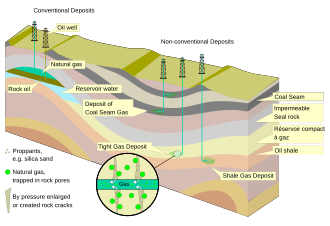Shale gas
Shale gas is a type of natural gas that is found trapped within shale formations. Shale gas has become an increasingly important source of natural gas in the United States and other parts of the world since the start of the 21st century, thanks to advances in hydraulic fracturing (fracking) and horizontal drilling technologies. These technologies have enabled the economical extraction of shale gas from formations that were previously uneconomical to produce.
Overview
Shale formations are fine-grained sedimentary rocks that can be rich sources of petroleum and natural gas. The gas in shale formations is typically trapped within the rock matrix, making it more difficult to extract than gas in more permeable formations. The development of hydraulic fracturing and horizontal drilling has made it possible to access these tight gas resources. Hydraulic fracturing involves injecting a high-pressure fluid into the shale formation to create fractures, which allow the gas to flow into the wellbore. Horizontal drilling allows for the drilling of wells that extend horizontally through the shale layer, increasing the exposure of the well to the gas-bearing formation.
Environmental Concerns
The extraction of shale gas has raised environmental concerns, particularly regarding the potential for groundwater contamination, the use of large volumes of water in the fracking process, and the release of methane, a potent greenhouse gas. There are also concerns about the induced seismicity (earthquakes) associated with hydraulic fracturing operations.
Economic Impact
The exploitation of shale gas has had a significant economic impact, particularly in the United States, where it has led to a substantial decrease in natural gas prices and has significantly reduced the country's reliance on imported energy. The shale gas boom has also contributed to job creation in the energy sector and has had a positive effect on the economy in regions where shale gas deposits are found.
Regulation
The regulation of shale gas extraction varies by country and region. In the United States, the regulation of hydraulic fracturing is primarily the responsibility of state governments, with federal regulations applying to certain aspects of the process, such as air and water quality standards. In Europe, some countries have embraced the technology, while others have imposed moratoriums or outright bans on hydraulic fracturing due to environmental concerns.
Future of Shale Gas
The future of shale gas is subject to a variety of factors, including technological advancements, environmental regulations, market dynamics, and geopolitical considerations. While shale gas is expected to continue to play a significant role in the global energy mix, the extent of its impact will depend on how these factors evolve.
Transform your life with W8MD's budget GLP-1 injections from $125.
W8MD offers a medical weight loss program to lose weight in Philadelphia. Our physician-supervised medical weight loss provides:
- Most insurances accepted or discounted self-pay rates. We will obtain insurance prior authorizations if needed.
- Generic GLP1 weight loss injections from $125 for the starting dose.
- Also offer prescription weight loss medications including Phentermine, Qsymia, Diethylpropion, Contrave etc.
NYC weight loss doctor appointments
Start your NYC weight loss journey today at our NYC medical weight loss and Philadelphia medical weight loss clinics.
- Call 718-946-5500 to lose weight in NYC or for medical weight loss in Philadelphia 215-676-2334.
- Tags:NYC medical weight loss, Philadelphia lose weight Zepbound NYC, Budget GLP1 weight loss injections, Wegovy Philadelphia, Wegovy NYC, Philadelphia medical weight loss, Brookly weight loss and Wegovy NYC
|
WikiMD's Wellness Encyclopedia |
| Let Food Be Thy Medicine Medicine Thy Food - Hippocrates |
Medical Disclaimer: WikiMD is not a substitute for professional medical advice. The information on WikiMD is provided as an information resource only, may be incorrect, outdated or misleading, and is not to be used or relied on for any diagnostic or treatment purposes. Please consult your health care provider before making any healthcare decisions or for guidance about a specific medical condition. WikiMD expressly disclaims responsibility, and shall have no liability, for any damages, loss, injury, or liability whatsoever suffered as a result of your reliance on the information contained in this site. By visiting this site you agree to the foregoing terms and conditions, which may from time to time be changed or supplemented by WikiMD. If you do not agree to the foregoing terms and conditions, you should not enter or use this site. See full disclaimer.
Credits:Most images are courtesy of Wikimedia commons, and templates, categories Wikipedia, licensed under CC BY SA or similar.
Contributors: Prab R. Tumpati, MD





